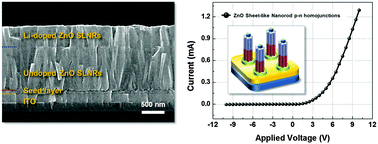Solution processed vertically stacked ZnO sheet-like nanorod p–n homojunctions and their application as UV photodetectors†
Abstract
One long-standing goal in the development of one-dimensional nanostructured electronic devices is to facilitate the ongoing trend of miniaturization so as to enable ultralow power operation. Zinc oxide (ZnO) nanostructures, which have a direct and wide bandgap, are a central component in numerous electronic and optoelectronic applications. Here, we address vertically stacked ZnO sheet-like nanorod (SLNR) p–n homojunctions composed of single-crystalline undoped (n-type) and Li-doped (p-type) ZnO SLNRs by a multi-step solution-based hydrothermal route. Precise control of the molar concentration represented one of the basic factors in ensuring that the p–n homojunctions possessed appropriate densities and suitable morphologies. An extensive analysis of the luminescence features was carried out in order to identify p-type conduction in the Li-doped ZnO SLNRs. In addition, the SLNR-based p–n homojunctions exhibited distinct electrical features that validated their potential use as ultraviolet photodetectors, thereby spurring progress in the development of practical optoelectronics.


 Please wait while we load your content...
Please wait while we load your content...